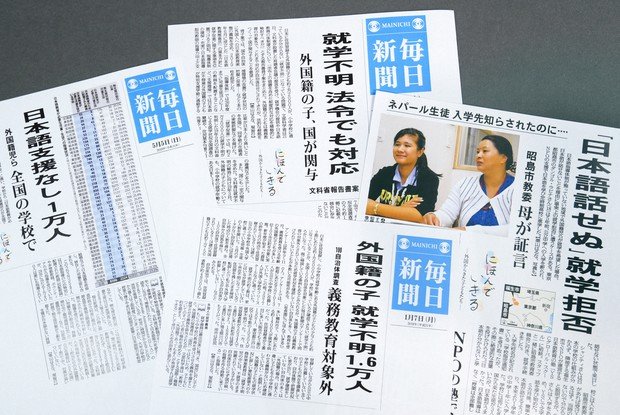
Learning Japanese News Headlines
Published: 2025-04-30 06:23:27
Reading Japanese news headlines can be a challenging but rewarding skill for learners. Unlike everyday Japanese, news headlines use compact grammar, formal expressions, and specialized vocabulary that require different reading strategies. This guide will help you break down common structures, key vocabulary, and useful techniques to improve your news-reading comprehension.
Understanding Japanese News Headlines: A Guide for Learners
Understanding Japanese news headlines helps learners grasp concise grammar, vocabulary, and context used in media. This guide breaks down headline structures to improve reading skills, comprehension, and real-world language application.
Why Are Japanese News Headlines Difficult?
Japanese news headlines often look very different from normal sentences due to several unique characteristics:
Omission of Subjects and Verbs
- To make headlines more concise, subjects (who/what) and auxiliary verbs (like です・だ・する) are often removed.
- Example:
日本経済回復へ (Nihon keizai kaifuku e) → “[The] Japanese economy [is] recovering.”
Frequent Use of Passive Voice (受動態, judōtai)
- The passive form is commonly used to make the statement sound neutral and formal.
- Example:
新法案可決される (Shin hōan kaketsu sareru) → “The new bill is passed.”
Kanji-Dense Writing
- Since kanji take up less space than hiragana, they are heavily used in headlines.
- Example:
感染拡大 (Kansen kakudai) → "Infection spread" (instead of writing in full: 感染が拡大している).
Abbreviations and Shortened Phrases
- Long words are often shortened to fit within space constraints.
- Example:
コロナ感染拡大 (Korona kansen kakudai) → "COVID-19 infections spreading" (instead of writing "コロナウイルス感染拡大").
If you're looking to improve your daily conversations, this detailed guide on how to make requests in Japanese offers essential phrases and usage tips for learners of all levels.

Use of Formal and Written Expressions
- Written Japanese (especially news) tends to be more formal than spoken Japanese.
- Many grammatical structures are different from daily conversations.
Common Grammar Patterns in Japanese News Headlines
To decode headlines effectively, you need to recognize certain grammatical shortcuts commonly used in Japanese news.
1. Omission of Copula (です・だ・である)
In headlines, the copula (です・だ・である) is often omitted.
Example:
政府新対策発表 (Seifu shin taisaku happyō)
→ "[The] government announces new measures."
(Full sentence: 政府は新しい対策を発表した。)
2. Passive Voice (受動態, judōtai)
News headlines often use the passive form to make statements sound more neutral and formal.
Example:
新法案可決される (Shin hōan kaketsu sareru)
→ "The new bill is passed."
(Full sentence: 新しい法案が可決された。)
3.Noun Modifications (名詞の修飾)
Headlines frequently string multiple nouns together to create compressed descriptions.
Example:
政府の新対策 (Seifu no shin taisaku)
→ "The government’s new measures."
(Full sentence: 政府は新しい対策を発表した。)
4. Use of ~へ and ~に for Future Events
The particle へ (e) or に (ni) is often used in headlines to indicate future actions.
Example:
総理訪米へ (Sōri hōbei e)
→ "The Prime Minister is going to visit the U.S."
(Full sentence: 総理大臣はアメリカを訪問する予定だ。)
五輪開催に向け準備 (Gorin kaisai ni muke junbi)
→ "Preparations for the Olympics."
5. Use of Abbreviations and Katakana Words
Many loanwords and abbreviations are commonly used in headlines.
Example:
コロナ感染拡大 (Korona kansen kakudai)
→ "COVID-19 infections spreading."
AI技術進化 (AI gijutsu shinka)
→ "AI technology advancement."
Build a solid foundation for the JLPT N3 by mastering essential vocabulary with our comprehensive JLPT N3 Vocabulary List.
Essential Vocabulary for Reading Japanese News Headlines
Here are some frequently used kanji and words in news headlines:
| Kanji | Reading | Meaning |
| 政府 | せいふ (seifu) | Government |
| 経済 | けいざい (keizai) | Economy |
| 速報 | そくほう (sokuhō) | Breaking news |
| 選挙 | せんきょ (senkyo) | Election |
| 事故 | じこ (jiko) | Accident |
| 感染 | かんせん (kansen) | Infection |
| 発表 | はっぴょう (happyō) | Announcement |
| 外交 | がいこう (gaikō) | Diplomacy |
Strategies for Understanding Japanese News Headlines
Understanding Japanese news headlines requires familiarity with concise grammar, kanji compounds, and context-based interpretation. Headlines often omit particles and use passive or formal verb forms. Learning common news vocabulary and practicing with real headlines can significantly boost comprehension. Regular exposure helps in recognizing patterns and decoding meaning quickly.
1. Break Down Sentences into Chunks
When reading a headline, identify the key words and mentally reconstruct the missing elements.
Example:
政府 新対策 発表 (Seifu shin taisaku happyō)
(Government new measures announcement)
“The government announces new measures.”
2. Learn Common News Terminology
Familiarize yourself with frequently used kanji compounds and phrases found in news articles.
3. Use a Bilingual News Source
Start with NHK News Web Easy, which provides simplified articles with furigana and English translations.
4. Read News Regularly
Make a habit of reading short articles daily, even if you don’t understand everything at first.
5. Use Dictionary and Translation Tools Wisely
Tools like Yomichan, Jisho, and Google Translate can help, but avoid over-relying on them.
Check the official outcomes and next steps in our detailed guide on the NAT Japanese Test April 2025 Result.

Frequently Asked Questions (FAQs)
1. Why do Japanese news headlines often omit particles and verbs?
To make them as short and concise as possible while still conveying key information.
2. How can I practice reading Japanese news?
Start with NHK News Web Easy for simplified articles and gradually move to sources like Asahi or Yomiuri.
3. What are the best online resources for reading Japanese news?
✔ NHK News Web Easy (for beginners)
✔ Asahi Shimbun / Yomiuri Shimbun (for advanced learners)
✔ Yahoo! Japan News (for trending topics)
4.Is there a specific JLPT level required to read Japanese news?
✔ JLPT N3-N1 learners will find news reading easier.
✔ Beginners should start with short headlines and simple articles.
5. Are news headlines different from spoken Japanese?
Yes! Headlines are more compact and formal, whereas spoken Japanese is more relaxed and conversational.
Conclusion: Start Small, Stay Consistent
Learning Japanese news headlines may seem intimidating at first, but with patience and regular practice, you’ll soon start to notice patterns and become familiar with common structures. Start with simplified resources, learn essential vocabulary, and take time to break down each headline. Over time, not only will your reading skills improve, but you'll also gain cultural and contextual insight into Japanese current affairs.
The more headlines you read, the more naturally the language will come to you. Keep reading, stay curious, and enjoy the journey of understanding Japanese through its real-world lens.
